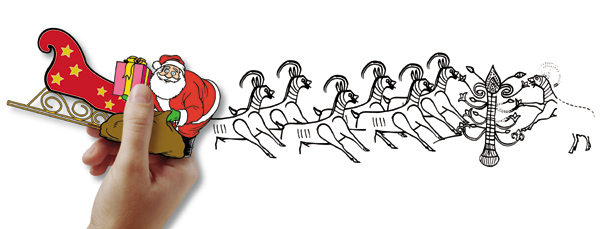Santa and His Asherah
Endnotes
Lucian of Samosata, The Syrian Goddess 49, trans. Harold W. Attridge and Robert A. Oden, Society of Biblical Literature Texts and Translations, Graeco-Roman Religion Series (Missoula, MT: Scholars Press, 1976), pp. 52–55. Because it is composed in Ionic, rather than Lucian’s usual Attic Greek, the work is widely believed to be misattributed. Possibly it was written by Lycias of Sarasota, with whom Lucian is often confused.
See my forthcoming study Sex and the Single Godhead. Asherah was also called ’Elah, “the Goddess,” corresponding to ’El, “the God.” Indeed, as ’Elah is to ’El, so Asherah is to Asher, a common title for the God of Israel utterly unknown to scholars. The problem is that ‘asher is generally misunderstood as the relative pronoun “who, that, which.” Once this simple error is corrected, we find the divine name Asher on virtually every page of the Hebrew Bible. Thus, God’s words to Moses in Exodus 3:14, “‘ehyeh ‘asher ‘ehyeh,” mistranslated in the King James Version as “I am that I am,” must really be rendered “I am Asher, I am.” Similarly, the opening of the Decalogue is not “I am the Lord your God who brought you out from the land of Egypt,” but “I, the Lord your God, Asher, brought you out…” Doubtless other examples lurk behind seemingly innocuous “who/what/which’s.” Another source of confusion is the term ‘ashrey, which is generally misinterpreted to mean “how happy!” but which in fact is the majestic dual of ‘Asher. For example, Psalm 84:5 should be translated, not “Happy are those who dwell in your house; they will ever praise you,” but “/Ashrey, those who dwell in your house will ever praise you.” /Asher/Ashrey is ultimately related to Egyptian Osiris and Mesopotamian Asshur (see William F. Albright, “The Evolution of the West-Semitic Divinity ‘An-‘Anat-‘Attä,” American Journal of Semitic Languages and Literatures 41 [1925], p. 99).
For a discussion of the inscription, see Ruth Hestrin, “Understanding Asherah—Exploring Semitic Iconography,” BAR 17:05.
For a popular treatment, see Frank M. Cross, Canaanite Myth and Hebrew Epic (Cambridge, MA: Harvard Univ. Press, 1973), pp. 3–75.
Most of our knowledge of Canaanite religion comes from Ugarit (modern Ras Shamra), a coastal city in northern Syria. Ugarit flourished from the 15th century B.C.E. until c. 1200, when it was conquered by the Hittites. The site was rediscovered in 1928 by a Syrian plowman.
“You are great, ‘El, you are truly wise; your gray beard truly instructs you” (Michael D. Coogan, Stories from Ancient Canaan [Louisville, KY: Westminster Press, 1978], p. 101; the bearded ’El is portrayed on the cover).
Ugaritic was written mostly without vowels. It was a strange language: The word l, for instance, meant “to,” “from,” “yes” and “no”—which probably explains why Ugarit was so easily conquered by the enemy.
This translation was definitively established by Albright (“Dwarf Craftsmen in the Keret Epic and Elsewhere in North-west Semitic Mythology,” Israel Exploration Journal 4 [1954], pp. 1–4) and is superior to the more common rendering, “handmaid’s sons.”
As in the Ugaritic epic of Kirta, wherein ’El appears to the hero in a dream and offers horses, chariots, riches, etc. For the text, see Coogan, Stories from Ancient Canaan, pp. 52–74.
See Choon Leong Seow, “The Syro-Palestinian Context of Solomon’s Dream,” Harvard Theological Review 77 (1984) pp. 141–152.
On the role of Mt. Zaphon (modern Jebel ‘el-’Aqra) in Ugaritic mythology, see Coogan, Stories from Ancient Canaan, pp. 13, 22.
The image of cherubim as pudgy toddlers reflects classical depictions of the spirits of Love and has no basis in Near Eastern iconography. Scholars agree that cherubs were hybrid beasts, winged lions with human or animal heads. They symbolized the power of the storm. See Albright, “What Were the Cherubim?” Biblical Archaeologist 1 (1938), pp. 1–3, and the accompanying illustrations.
The received text continues “or good,” but this is simply a gloss by a copyist who knew a variant, “he knows if you’ve been good,” itself a corruption influenced by the presence of “good” in the following line. Note that my reconstructed version has a more regular meter (3:3:3) than the canonical rendition.
Bizarrely, the lost precursor to this text appears to have found its way into Greek literature. Compare Xenophanes, fragment 24, “He sees everything, he knows everything, he hears everything.” On the debt of Xenophanes and other pre-Socratic philosophers to the ancient Near East, see M.L. West, Early Greek Philosophy and the Orient (Oxford: Clarendon Press, 1971).

